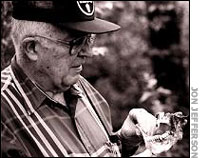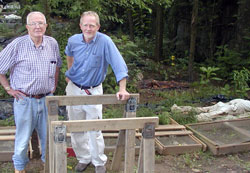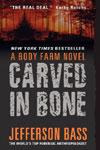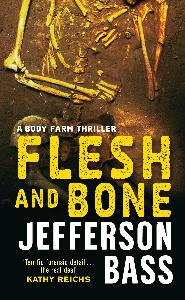|
We asked Jefferson Bass: What is the Body Farm, and
what inspired you
to create it? And exclusively for the UK and Shots Ezine he explained:
The Body
Farm is an outdoor research laboratory, you might
say, at the University of Tennessee. Its
official name is the Anthropology
Research Facility, but it’s much better known as the Body
Farm, a nickname
Patricia Cornwell used as the title of one of her bestselling novels.
The
facility was the first scientific research lab devoted to the study of
human
decomposition in what’s known as the “extended
postmortem interval,” the weeks
and months after death.

Two main
factors combined to inspire the Body Farm. First,
when I came to the University of Tennessee in 1971, the Tennessee
Medical
Examiner asked if I would serve as a consultant to his staff and help
identify
unknown bodies; when I said “yes,” I soon started
receiving bodies—most of them
badly decayed—and I needed somewhere to store them until I
could examine them.
Then, in 1977, I was asked to examine a headless male corpse that still
had
quite a bit of tissue on the bones. From my prior experience, I
initially
estimated that the man had been dead somewhere between six months and a
year; I
soon learned, though, that the man had actually been killed 113 years
before,
in a battle in the American Civil War! That case highlighted the need
for
research on the processes and timing of postmortem human decomposition.
Three
years later we set up the research facility that is now known as the
Body Farm.

Today the
Body Farm occupies about three acres of wooded
hillside, inside a chainlink security fence and a wooden privacy fence.
Using
donated bodies, forensic anthropology graduate students and faculty
study
various aspects of decomposition. Research runs the gamut from fairly
simple—how do changes in temperature, humidity, clothing, and
other variables
affect the rate of decay?—to complicated experiments with
ground-penetrating radar
and chemical analysis of compounds given off by buried bodies. The Body
Farm’s
data on the sequence and timing of human decay is used all over the
world to
help determine “time since death” when a
decomposing body is found.
After a body
has spent about a
year at the Body Farm, we clean off the bones and add them to our
skeletal
collection, which is extremely important. UT’s Anthropology
Department now has
the world’s largest collection of modern skeletons whose age,
race, and sex is
known. That’s an incredible teaching tool for our
anthropology students. It’s
also an important source of reference data for anthropologists and
other
forensic scientists. The human skeleton is changing surprisingly
quickly—during
just the past century, for instance, Americans have gotten several
inches
taller, on the average—so it’s important for
anthropologists to track that sort
skeletal changes. That’s not just for the sake of scientific
knowledge, either.
When the bones of an unknown murder victim are found, their
measurements can be
compared to all the data from our collection to help pin down the age,
race,
and sex of that victim.

In 1981,
the first year of the research program, we
received just four donated bodies. These days, we get more than a
hundred every
year. In 2006, we got 107; during 2007, we received about140. As more
and more
people learn about the Body Farm and how the research there helps solve
crimes,
the donations just keep going up. We’re about to expand the
Body Farm by adding
another 15 acres of land, and we’ll build a new $1-milion
processing laboratory
as part of the expansion.

Who
is Jefferson Bass?

William M. Bass is a U.S. forensic
anthropologist, renowned for his
research on human osteology and human decomposition. He has also
assisted
federal, local, and non-US authorities in the identification of human
remains. Currently
retired from teaching, he still plays an active research role at the
Forensic
Anthropology Research Facility, which he founded. The Facility is more
popularly known as the "Body Farm. Bass has also described the body
farm
as "Death's Acre" – the title of the bestselling book on his
life and
career, co-written with journalist Jon Jefferson.

Veteran
journalist Jon Jefferson,
a documentary film-maker for such networks as A&E, the History
Channel, and
the National Geographic Channel, had previously worked as a staff
science
writer at Oak Ridge National Laboratory, one of the most advanced
centers in
the world for research and development. He has won numerous awards for
his work
and he lives in Knoxville
only
a few miles from Bass.
 As “Jefferson
Bass” Bass and Jefferson have also written two fictional
works,
As “Jefferson
Bass” Bass and Jefferson have also written two fictional
works,
Carved
in Bone
published by Quercus Books April 2008 £6.99 pbk
"Fantastic forensic
detail and an engaging hero … an authoritative, compelling
new voice to the
forensic mystery."
—
Jeff Abbott, USA
Today bestselling author of PANIC
 Flesh
and Bone
will be
published by Quercus Books Oct 2008 6.99 pbk
Flesh
and Bone
will be
published by Quercus Books Oct 2008 6.99 pbk
"Razor sharp ... Fans of
forensic fiction will want to add this author to their list of
favorites."
—
Booklist
Read an excerpt
from Carved in Bone
Quercus will be
publishing exclusively for Waterstones the non-fiction Beyond
The Body Farm pbk £11,99 April 2008. The cases in this book are told with
gruesome and fascinating detail and will appeal to fans of CSI, Silent
Witness,
Jefferson Bass’ novels and true crime fans alike.
For those of you who are
interested in finding out more on Bill Bass and
The Body Farm visit these sites:
Jefferson Bass Official Website: http://www.jeffersonbass.com/
http://www.crimelibrary.com/criminal_mind/forensics/bill_bass/
|


